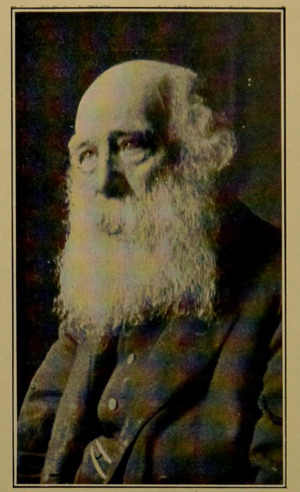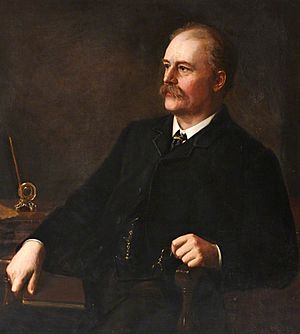Barnett Samuel Marks facts for kids
Barnett Samuel Marks (born in Cardiff in 1827, died in London in 1916) was a Welsh-Jewish artist. He was famous for painting portraits of people. He was also known for his "social realism" paintings, which showed the lives of ordinary people, especially those who were struggling.
Early Life in Cardiff
Barnett Samuel Marks was born in Cardiff on May 8, 1827. He was the first child of Mark Lyon Marks and Ann Michael. His father was a watchmaker and auctioneer. He was important in starting the Jewish community in Cardiff. His mother's family had helped create the first big Jewish community in Wales, in Swansea.
Barnett went to school privately in Cardiff. He was very good at art and painting portraits from a young age. He also played the piano and a musical instrument called the ophicleide. He took part in cultural events in Cardiff. To earn more money, he taught art classes. His art studio was at his family's home on St Mary Street in Cardiff.
In 1856, he joined a social group called the Freemasons. He played cricket at Cardiff Arms Park with other Freemasons. In late 1857, his painting career got a big boost. A rich lady, the Marchioness of Bute, started to support his work.
In 1858, Marks married his cousin, Zipporah, from Swansea. He then moved to his own home and studio on Charles Street in Cardiff. From 1859, his paintings were regularly shown at the Royal Academy Summer Exhibition in London.
In 1859, he joined the new Volunteer Force. The next year, he had to serve on a jury. This experience deeply affected him. He saw many poor children in the town. He used the image of a young boy to show their difficult lives. This led to a series of paintings that became very popular at the Royal Academy.
In the early 1860s, he supported the Cardiff Free Library. He was on its committee from 1865 to 1866. He also taught art classes there for young workers.
Life in London
In 1866, Barnett Samuel Marks moved to London. He had a growing reputation as a portrait painter. He also had a young family to educate. His art studio was first on Great Portland Street, then Westbourne Terrace. From 1874, it was in Fitzroy Square. Famous artists and writers lived nearby.
He showed his art in many private exhibitions. He also taught art at Jewish schools in London. He continued to paint portraits. In London, he was very moved by the many homeless children on the streets. The work of Dr. Barnardo, who helped these children, inspired him. Marks painted a series of pictures called "diptychs." These showed groups of boys before and after they were rescued. Art critics and even the famous art writer John Ruskin praised these paintings.
In 1879, he joined another Freemasons group in London. He painted at least two portraits for their main building, the Freemasons' Hall. After a big fire there in 1883, he was asked to paint copies of two important damaged paintings. He became a leader in this group. Famous people like Bram Stoker, who wrote "Dracula," were also members.
His family lived in Ealing, a country area near London, from 1867 to about 1897. Marks was active in the local community there. He helped start the Ealing Free Library, which opened in 1883.
He stayed in touch with Cardiff. He helped organize art exhibitions there, like the first major public art show in 1870. He became a full member of the Royal Cambrian Academy in 1887. He gave paintings to the Cardiff Town Council. He also received many requests to paint portraits for them. He was president of the Art Section of the Cymmrodorion Society. He gave a speech about art at the National Eisteddfod of Wales in Cardiff in 1883. He also judged art for the Eisteddfod in 1885. In 1897, he attended the opening of the New Synagogue in Cardiff. He had been the President of the Cardiff Hebrew Congregation.
In 1892, he was asked to paint a portrait of the Prince of Wales (who later became King Edward VII). This painting was for a public building in Calcutta (now Kolkata), India. The next year, another Freemason group asked him to paint a portrait of Edward, First Earl of Lathom. He continued painting portraits until at least 1898, when he was in his early 70s. He also showed many still life paintings (pictures of objects) at the Royal Cambrian Academy later in his life.
He was a committee member for several Jewish schools. He was also Vice-President of a charity called "The Jewish Board of Guardians" which helped people find work.
Around 1897, the Marks family moved to Kensington, London. Barnett Samuel Marks passed away there on December 6, 1916.
Selected Works
Barnett Samuel Marks created many important paintings. Here are a few examples:
- Portrait of John Hemingway (1854): A painting of a stonemason who worked on the Britannia Bridge.
- The Dock, a Reminiscence of the Court (around 1868–1871): This painting is now in the Walker Art Gallery in Liverpool.
- Saved from the Streets, Portraits of Boys on Board the 'Chichester' Training Ship (around 1872): This artwork shows boys before and after they were helped. It is at the National Maritime Museum.
- Board School Children or Some of our New Pupils (1874): This painting shows children in a London school. It is at the National Museum of Wales.
- Portrait of Lord Aberdare (1880): Lord Aberdare said Marks was "not only an excellent artist... but he is one of the best-hearted men I know."
- Self-portrait (1884): A painting of himself, now at Ealing Central Library.
- Full-length portrait of HRH George, Prince of Wales (1885): A large painting for the Freemasons' Hall.
- Portrait of John Allen Brown (1888): A painting of the first chairman of the Ealing Free Library.
- Portrait of Edward, 1st Earl of Lathom (1893): Another important portrait for the Freemasons.
Family
Barnett Samuel and Zipporah Marks had six children:
- Michael Herbert Marks (1858-1943): He worked at the London Stock Exchange. He had one daughter, Gladys Mary Jessie Marks, who was Barnett Samuel Marks' only grandchild.
- Constance Isabelle Marks (1860-1940): She earned a degree from the University of London in 1888. She taught math and was part of the London Mathematical Society.
- Gertrude Catherine Marks (1863-1942): She was a painter and showed her art at the Royal Cambrian Academy. She also became a midwife in 1905 and wrote a guide for maternity nurses.
- Florence Helena Marks (1864-1947): She was a concert pianist and music teacher. She wrote a book about piano sonatas by Mozart. She also wrote music for two songs with words written by her father.
- Anne Marks (1866-1927): She was a painter who studied art and showed her work at the Royal Academy. She specialized in animal paintings, especially cats. She wrote and illustrated a book called "The Cat in History, Legend and Art."
- Percy Leman Marks (1867-1941): He was an architect and wrote several books about architecture. He was also involved with the Board of Deputies of British Jews.




